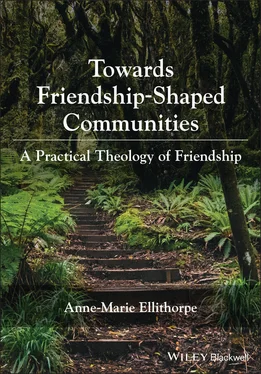1 ...8 9 10 12 13 14 ...23 28 28Alasdair MacIntyre, After Virtue, 3rd ed. (Notre Dame: University of Notre Dame Press, 2007), 187–188.
29 29David Smith and James K.A. Smith, “Introduction: Practices, Faith, and Pedagogy,” in Teaching and Christian Practices: Reshaping Faith and Learning, ed. David Smith and James K.A. Smith (Grand Rapids: Eerdmans, 2011), 9.
30 30Smith and Smith, “Introduction: Practices, Faith, and Pedagogy,” 8–9.
31 31Craig Dykstra and Dorothy C. Bass, “A Theological Understanding of Christian Practices,” in Practicing Theology: Beliefs and Practices in Christian Life, ed. Miroslav Volf and Dorothy C. Bass (Grand Rapids: Eerdmans, 2002), 18.
32 32Miroslav Volf and Dorothy C. Bass, eds., Practicing Theology: Beliefs and Practices in Christian Life (Grand Rapids: Eerdmans, 2002), 21.
33 33Dykstra and Bass, “A Theological Understanding of Christian Practices,” 27–28.
34 34Charles Taylor, Modern Social Imaginaries (Durham: Duke University Press, 2004), 23. The term imaginary is used to talk about shared life, although used in slightly different ways by different scholars. For Cornelius Castoriadis, “the imaginary is a culture’s ethos”; for Jacques Lacan, it is a “fantasy”; for Benedict Anderson and Charles Taylor, it is a shared implicit “cognitive schema.” See Claudia Strauss, “The Imaginary,” Anthropological Theory 6, no. 3 (2006): 323.
35 35Taylor, Modern Social Imaginaries, 23.
36 36James K.A. Smith, Desiring the Kingdom: Worship, Worldview, and Cultural Formation (Grand Rapids: Baker, 2009), 66.
37 37Charles Taylor, A Secular Age (Cambridge: Harvard University Press, 2007), 172.
38 38Contrast for example, the few, yet deeply loyal, life-long German friends with a relatively open, loose, and fluid approach to friendship in the United States. See Greg Nees, Germany: Unraveling an Enigma (Yarmouth, ME: Intercultural Press, 2000), 66–68. Variations in the experience of friendship between North American and African settings also reflect variations in social reality and social understandings. See, for example, Glenn Adams and Victoria C. Plaut, “The Cultural Grounding of Personal Relationship: Friendship in North American and West African Worlds,” Personal Relationships 10, no. 3 (2003): 346.
39 39Willie James Jennings, The Christian Imagination: Theology and the Origins of Race (New Haven: Yale University Press, 2010), 4.
40 40Jennings, The Christian Imagination, 6.
41 41See Richard Rorty, “Philosophy as Science, as Metaphor, and as Politics,” in Essays on Heidegger and Others (Cambridge: Cambridge University Press, 1991), 13.
42 42Taylor, Modern Social Imaginaries, 6.
43 43Taylor, Modern Social Imaginaries, 6.
44 44Strauss, “The Imaginary,” 323.
45 45Strauss, “The Imaginary,” 323.
46 46Taylor, Secular Age, 175. Italics original.
47 47Taylor, Secular Age, 175.
48 48James K.A. Smith, to the contrary, asserts that despite a dynamic and dialectical relationship between the two, practices precede and carry the understanding. See Smith, Desiring the Kingdom, 67 n.53.
49 49Wenger, Communities of Practice, 83. See also Kent Eilers, “New Monastic Social Imagination: Theological Retrieval For Ecclesial Renewal,” American Theological Inquiry: A Biannual Journal of Theology, Culture & History 6, no. 2 (2013): 54–55.
50 50Smith and Smith, “Introduction: Practices, Faith, and Pedagogy,” 13.
51 51James K.A. Smith, Imagining the Kingdom: How Worship Works (Grand Rapids: Baker, 2013), 148.
52 52Stephen Pattison, The Challenge of Practical Theology: Selected Essays (London: Jessica Kingsley, 2007), 284.
53 53Elaine Graham, Heather Walton, and Frances Ward, Theological Reflection: Methods (London: SCM, 2005), 138.
54 54In an appendix at the end of this book, I trace the development of critical correlation, followed by a consideration of objections to, challenges with, and strengths of this methodology.
55 55David Tracy, Blessed Rage for Order: The New Pluralism in Theology, Reprint ed. (Chicago: University of Chicago Press, 1975), 32.
56 56James K.A. Smith, Who’s Afraid of Postmodernism? Taking Derrida, Lyotard, and Foucault to Church (Grand Rapids: Baker, 2006), 126. See also Witi Ihimaera, The Whale Rider (Auckland: Mandarin, 1992). The movie is inspired by the book, but differs from it in emphasis, narration, and detail.
57 57Witi Ihimaera, The Parihaka Woman (Auckland: Random House, 2011).
58 58Hirini Kaa, “He Ngākau Hou: Te Hāhi Mihinare and the Renegotiation of Mātauranga, c.1800–1992” (PhD thesis, University of Auckland, 2014), 14.
59 59Kaa, “He Ngākau Hou,” 257.
60 60Kaa, “He Ngākau Hou,” 257.
61 61See also Claire Wolfteich, “Animating Questions: Spirituality and Practical Theology,” International Journal of Practical Theology 13, no. 1 (2009): 123.
62 62Neil Darragh, At Home in the Earth: Seeking an Earth-Centred Spirituality (Auckland: Accent, 2000), 2.
63 63Smith, Who’s Afraid, 127.
64 64Smith, Who’s Afraid, 127.
65 65Linda Tuhiwai Smith, “Kaupapa Māori Research- Some Kaupapa Māori Principles,” in Kaupapa Rangahau A Reader: A Collection of Readings from the Kaupapa Māori Research Workshop Series Led, ed. L. Pihama and K. South (Te Kotahi Research Institute), 52.
66 66Wayne Manaaki Rihari Te Kaawa, “Re-visioning Christology through a Māori Lens” (PhD thesis, University of Otago, 2020), 19.
67 67Te Kaawa, “Re-visioning Christology,” 19.
68 68Richard R. Osmer, “Toward a New Story of Practical Theology,” International Journal of Practical Theology 16, no. 1 (2012): 72.
69 69Osmer, “Toward a New Story,” 72.
70 70David Tracy, “A Correlational Model of Practical Theology Revisited,” in Religion, Diversity and Conflict, ed. Edward Foley (Munster: LIT Verlag, 2011), 50.
71 71Don S. Browning, A Fundamental Practical Theology (Minneapolis: Fortress, 1996), 8.
72 72Browning, A Fundamental Practical Theology, 130.
73 73Browning, A Fundamental Practical Theology, 48–49.
74 74See Don S. Browning, “Toward a Fundamental and Strategic Practical Theology,” in Equality and the Family: A Fundamental, Practical Theology of Children, Mothers, and Fathers in Modern Societies (Grand Rapids: Eerdmans, 2007), 13. Also Don S. Browning, “The Relation of Practical Theology to Theological Ethics,” in Equality and the Family: A Fundamental, Practical Theology of Children, Mothers, and Fathers in Modern Societies (Grand Rapids: Eerdmans, 2007), 396.
75 75Browning, A Fundamental Practical Theology, 49.
76 76Browning, “Toward,” 41.
77 77Tara K. Soughers, “Friendship with the Saints: A Practical Theological Reading of Teresa of Avila as a Spiritual Companion” (PhD diss., Boston University School of Theology, 2013), 34. See Browning, A Fundamental Practical Theology, 230–231.
78 78Browning, A Fundamental Practical Theology, 139.
79 79I have chosen to use the labels of First and Second Testament in my discussion of the Scriptures. The terminology of First Testament is inclusive of the Hebrew biblical texts, along with the Septuagint. The terminology of Second Testament seeks to avoid implications of in-group presuppositions or replacement theology. Yet I still make some use of the more common labels, particularly when using abbreviations.
80 80Browning, “Theological Ethics,” 396.
81 81Browning, “Toward,” 14. Browning draws on Gadamer’s approach to hermeneutics.
82 82See Charles Ringma, Gadamer’s Dialogical Hermeneutic: The Hermeneutics of Bultmann, of the New Testament Sociologists and of the Social Theologians in Dialogue with Gadamer’s Hermeneutic (Heidelberg: Universitätsverlag C. Winter, 1999), 23.
83 83Ringma, Gadamer’s Dialogical Hermeneutic, 49.
Читать дальше












